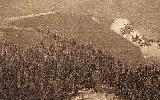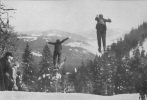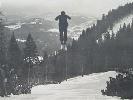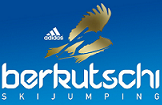Recent news:
4000th facility has been added to the Ski Jumping Hill Archive
7000th ski jumping hill added to the Archive!
New Granåsen ski jump in Trondheim inaugurated
Fire destroys ski jumps in Biberau-Biberschlag
Copper Peak: Funding of the renovation finally secured
Send us your ski jumping hill photos and information via email!
Latest updates:
2025-04-14
2025-04-13
2025-04-12
2025-04-11
2025-04-10
Advertisement:
Partner:




 Feldberg
Feldberg
Feldseewald
Data | History | Competitions | Contact | Map | Photo gallery | Comments
.
Max-Egon-Schanzen:
| K-Point: | 40 m |
| Further jumps: | K20 |
| Plastic matting: | no |
| Year of construction: | 1922 |
| Conversions: | 1927, 1949 |
| Status: | destroyed |
| Ski club: | Skizunft Feldberg |
| Coordinates: | 47.865909, 8.034771 ✔ 
 |
History:
As generally known the Black Forest is the cradle of German ski jumping, because it is known that already at about 1894 at Feldberg the first skiing competitions were held by immigrated Norwegians, who opened ski jumping for the public.
In 1899 someone called Bjarne Nielsen is said to have jumped an landed safely a distance of 19 m, because at that time winner was the one with the longest fallen distance.
In 1900 there was the first competition for the German championships, at which the winner is said to have jumped on 19 m. Further championships followed and with the very fast distribution of this kind of sports in 1905 the German Ski Association was founded. There were several ski jumping hills at Feldberg, which were built up at the beginning of each winter by the ski clubs which were founded at the beginning 20th century. It is known that many competitions took place on the Feldberghügel at Baldenweger Buck, which had a very dangerous outrun.
With the foundation of Skizunft Feldberg in 1922 its first goal was to convert the ski jumping hill at Feldseewald into a 40 meter hill was soon as possible. Its new hill name was due to Max Egon zu Fürstenberg, because the noble family from Freiburg made the construction possible with the donation of wood.
The Max-Egon-Schanze was only prepared for championships and the international Feldberg competition, which took place yearly from 1923 to 1934, training sessions where always held on the smaller jumps like at Seebuck. By the way, the every year very-well attended Eater competition was traditionally opened by the “Schwarzwaldgeist”, a jumper in a fancy dress. After the construction of Feldbergschanze at Fahler Loch in 1935, on which the tradition of the yearly Easter competition was continued, the jump lay idle and dilapidated.
In the end of 1940’s it was reactivated by the Skizunft and later again only lay down. A very last competition was held in middle 80’s at a regional youth tournament and after that the jumps belonged to the past forever.
Winners of the Easter Competition on Max-Egon-Schanze:
| 1922 | Bødker-Næss | NOR |
| 1923 | Sepp Allgaier | GER / Freiburg |
| 1924 | Finn Blytt | NOR |
| 1925 | Auguste Bischof | SUI |
| 1926 | Gustav Müller | GER / Bayrisch Zell |
| 1927 | Walter Glass III | GER / Klingenthal |
| 1928 | - | |
| 1929 | Walter Glass III | GER / Klingenthal |
| 1930 | Walter Glass III | GER / Klingenthal |
| 1931 | Knut Kobberstad | NOR |
| 1932 | Marcel Reymond | SUI |
| 1934-04-02 | Eistein Raabe | NOR |
 Competitions:
Competitions:
 Contact:
Contact:
 Map:
Map:
 Photo gallery:
Photo gallery:
Advertisement:




 Oslo
Oslo Warszawa
Warszawa Brig
Brig  Wilhelmsburg
Wilhelmsburg  Bled
Bled












































Post comment:
My Great-Grandfather
My Great-Grandfather is Auguste Bischof